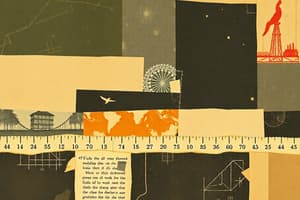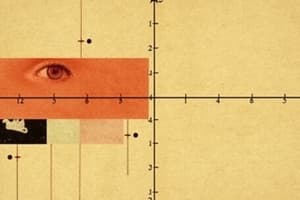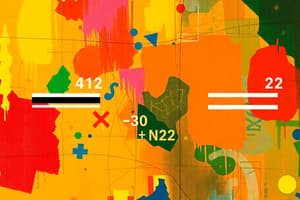Podcast
Questions and Answers
An inequality represents an infinite amount of numbers larger than -5. Which inequality represents the situation?
An inequality represents an infinite amount of numbers larger than -5. Which inequality represents the situation?
- X = -5
- X >= -5
- X < -5
- X > -5 (correct)
What must Graham do to complete his representation of x > 4?
What must Graham do to complete his representation of x > 4?
Draw an open circle at 4
Which best explains the number of possible solutions to the inequality x > 8 and x < 10?
Which best explains the number of possible solutions to the inequality x > 8 and x < 10?
There are infinite solutions because there is always another number between any two numbers.
The total number of running yards in a football game was less than 100. This is represented by the inequality ______.
The total number of running yards in a football game was less than 100. This is represented by the inequality ______.
Which statements below describe steps Geraldine may take to graph the inequality X < 6? (Select all that apply)
Which statements below describe steps Geraldine may take to graph the inequality X < 6? (Select all that apply)
Which graph represents the inequality X > 6?
Which graph represents the inequality X > 6?
An inequality represents an infinite amount of numbers smaller than 8. Which inequality represents the situation?
An inequality represents an infinite amount of numbers smaller than 8. Which inequality represents the situation?
Flashcards are hidden until you start studying
Study Notes
Graphing Inequalities on a Number Line
-
Inequality can represent an infinite set of values; for example, X > -5 indicates all numbers larger than -5.
-
To graph the inequality X > 4, an open circle is drawn at 4 on a number line, with shading extending to the right.
-
The inequalities x > 8 and x < 10 indicate that there is an infinite number of potential solutions between 8 and 10, as there are endlessly many numbers between any two given numbers.
-
For the inequality x < 100, an appropriate graph would show an open circle at 100 with shading to the left, indicating all numbers less than 100.
-
When graphing X < 6, specific actions include drawing an open circle at 6, shading to the left, and indicating all values less than 6.
-
To represent the inequality X > 6, the graph should include an open circle at 6 with shading to the right, displaying all numbers greater than 6.
-
The inequality X < 8 signifies an infinite range of numbers smaller than 8, requiring proper representation with an open circle at 8 on a number line.
Studying That Suits You
Use AI to generate personalized quizzes and flashcards to suit your learning preferences.




